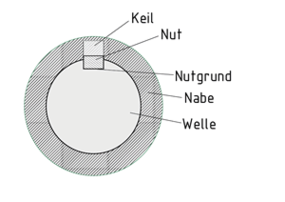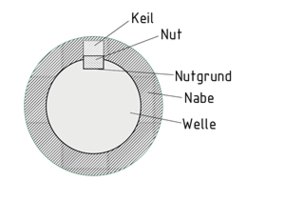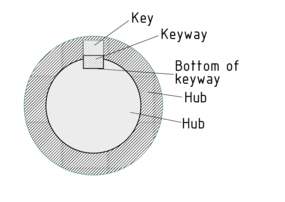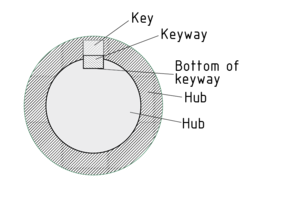
Choose one
or multiple languages
0,1,1
- German
- English
- Chinese
- Spanish
Key joint

Key joints are created by driving in keys to apply Contact pressure and form a Friction-based connection. A distinction is made between ordinary (longitudinal) and cotter (transverse) key joints. Their poor precision means key joints are only suitable for some applications, such as slow-running shafts. Due to their Resistance to soiling, they are often used for agricultural machinery, construction machinery and conveyors.
Ordinary key joints are frictional connections pure and simple. In the case of Shaft-Hub joints, the contact pressure is usually created by hammering in keys in the longitudinal direction. It is also possible to Force on the hub if a round-ended key is inserted into a shaft keyway.
Cotter key joints, which are particularly suitable for dynamic loads, also form a pre-tensioned mechanically locked connection due to elastic deformation in the components. This enables longitudinal forces to be transmitted. The friction-based connection stops the cotter keys from working loose.
Keilverbindung

Keilverbindungen werden bei Flächenpressungen durch Eintreiben von Keilen hergestellt, bei dem Reibschluss erzeugt wird. Unterschieden werden Längs- und Querkeilverbindungen. Wegen ihrer geringen Genauigkeit eignen sie sich nur für manche Einsatzzwecke, etwa langsam laufende Wellen. Wegen ihrer Schmutzunempfindlichkeit werden sie häufig für Land-, Bau- und Fördermaschinen verwendet.
Längskeilverbindungen sind reine Reibschlussverbindungen. Dabei wird die Pressung bei Wellen-Naben-Verbindungen meist durch Keile hergestellt, die mit Hammerschlägen in Längsrichtung eingetrieben werden. Möglich ist auch ein Auftreiben der Nabe, wenn ein rundstirniger Einlegekeil in eine Wellennut eingelegt wird.
Querkeilverbindungen, die insbesondere für dynamische Belastungen geeignet sind, weisen zudem vorgespannten Formschluss auf, der durch elastisches Verformen der Bauteile erzeugt wird. So können Längskräfte übertragen werden. Das Lösen der Querkeile wird durch Reibschluss verhindert.
键接

键接是通过压入键以施加接触压力而产生的,同时还形成了基于摩擦的连接。普通键接和销键连接间存在着一定的区别。由于精度较低,键接只适用于某些应用,例如减速轴。键接耐脏,因此它通常在农用机械、建筑机械和传动装置中应用。
普通的键接只是纯粹又简单的摩擦连接。在轴-轮毂连接中,其接触压力通常是在轴向锤入键时形成的。如果圆端的键插入到轴的键沟中,那么可能在轮毂上会有力的作用产生。
销键连接尤其适用于动态载荷,同时由于部件的弹性变形使其形成了预紧的机械紧锁连接。这使得纵向力可以被传递。基于摩擦连接可防止销键连接在工作时松脱。
带有键沟的轴和轮毂
近义词
普通键接
销键连接
Unión de chaveta

Las uniones de chaveta se crean colocando chavetas para aplicar presión de contacto y formar una conexión a base de fricción. Se debe distinguir entre las uniones de chaveta ordinarias (longitudinales) y las de pasador (transversales). Su mala precisión significa que las uniones de chaveta solo son adecuadas para algunas aplicaciones, como ejes de movimiento lento. Debido a su resistencia al ensuciamiento, a menudo se usan para maquinarias agrícolas, maquinarias para la construcción y transportadoras.
Las uniones de chaveta ordinarias son conexiones de fricción puras y simples. En el caso de las uniones de eje-conexión, la presión se crea usualmente martillando la chaveta en dirección longitudinal. También es posible forzar la conexión si se inserta una chaveta redondeada en el paso del eje.
Las uniones de chaveta de pasador, las cuales son particularmente adecuadas para las cargas dinámicas, también forman una conexión mecánicamente bloqueada pretensa debido a la deformación elástica de los componentes. Esto permite transmitir fuerzas longitudinales. La conexión a base de fricción evita que se aflojen los pasadores.
Eje y conexión con unión de chaveta
